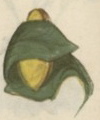







Lady Ætheldreda of Dun Breatan, the principal of our barony's herbalists' guild, taught butter-making to the children at an event during my lord's tenure as Minister of Children. They used the same procedure shown in the video on butter-making on the Happy Scientist website. A few tablespoons of cream were used per child, and each child had her or his own small plastic container with a tight-fitting lid that (s)he used both to make the butter and to carry it away at the end of the activity. My son (like several others) brought his butter out at feast later that evening and greatly relished using it. Those who left the site earlier in the day took their butter home with them.
I wasn't present during Lady Ætheldreda's class, so I don't know what information she gave the kids about medieval butter and buttermaking. But I can point you to a few resources you could use to put together a brief discussion.
The website of the Lisburn Historical Society hosts a photo of an early medieval butter churn that is described thus on page 76 of Nancy Edwards' The Archaeology of Early Medieval Ireland:
At Lissue an oak butter churn was found. Its circular base was made up of three parts joined with wooden pegs, and the walls were made of 19 carefully smoothed staves skilfully shaped so that the top of the vessel was oval rather than round. These were held in place by two wooden hoops fastened by iron clamps, the grip of the upper being further strenghthened by iron nails hammered into the staves. The vessel was completed with an iron rim mount with an everted lip to facilitate pouring held in place with iron nails, and an iron hoop fixed to the body of the vessel with iron cramps with two rings through which a rope could be passed to swing the churn.
A swinging churn works exactly as the shaken jar in the abovementioned video does. The entire churn moves, and momentum smacks the cream against the inside each time it reaches the end of a swing.
The National Museum of Scotland's website includes a photo of the lid of a dasher churn from the late-6th to early-7th century C.E. Folio 39 of the Mazarine Bible (printed in the middle of the15th century) has a bas de page illustration showing an ape using a dasher churn, and there is a woodcut from Il Cuoco Segreto Di Papa Pio V (dated 1570) that includes a man using one. Karen Larsdatter's site offers annotated links to a few other images of churns with dashers from the 13th through the 16th centuries.
This type of churn normally remains stationary. The agitation that separates the butterfat from the buttermilk is provided by the vigorous movement of the dasher within the cream.
Folio 59 of BNF Latin 9333 shows a woman making butter. I'm not sure what stage in the process is pictured, exactly--perhaps working it to remove the last of the buttermilk. The stages of buttermaking and the tools used to do it in the 18th and 19th centuries are discussed on the "Old and Interesting" website, and can probably be assumed to be similar to those of earlier centuries at least in the main.
Folio 58 in BNF Nouvelle acquisition latine 1673 and folio 57 of BNF Italien 1108 both show butter merchants at work. They appear to cut butter to order for the customer. The same practice was current in England in the early 20th century, according to the "Join Me in the 1900s" website.
Stefan's Florilegium contains a collection of posts, most including citations, related to the ways in which butter was used in the Middle Ages.
The images of pats and rounds of butter that appear at the top of this page are all from 15th-century manuscripts of the Book of Simple Medicines in the collection of the French National Library. In order from left to right, they come from folio 52v of BNF Nouvelle acquisition française 6593, folio 33 of BNF Français 12320, folio 77 of BNF Français 9137, and folio 52v of BNF Français 1309.
This page was written and is maintained by Coblaith Muimnech, who holds the copyright to all elements including all illustrations not excerpted from works more than 300 years old. Please do not reproduce any portion of it without express permission.
Click to visit Coblaith's homepage or the index to her articles on S.C.A. kids' activities.